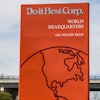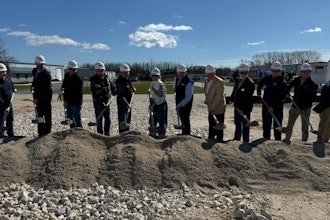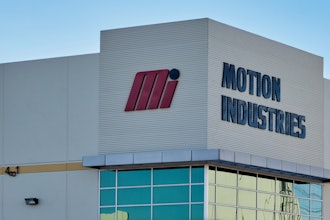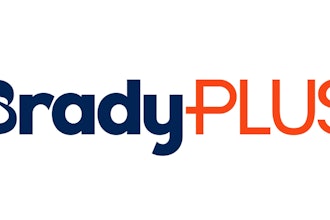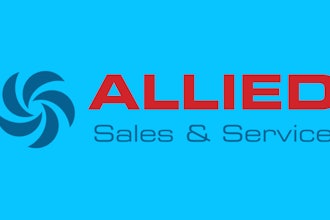P R I C I N G B R E W R E S E A R C H R E P O R T
Exploring the Two Different Approaches That B2B
Companies Are Using to Improve Their Pricing
© 2015 MindBrew, LLC. All rights reserved. This publication may not be reproduced or distributed in any form without MindBrew’s prior written permission. This publication contains the opinions of
MindBrew’s research and editorial organizations and should not be construed as statements of fact. The information contained in this publication has been obtained from sources believed to be
reliable, however MindBrew disclaims all warranties as to the accuracy, completeness or adequacy of such information and shall have no liability for errors, omissions or inadequacies in such
information. The opinions and information expressed herein are subject to change without notice.
From our vantage point here at
PricingBrew, it’s very clear that
“pricing improvement” has become
a mainstream priority in B2B.
We see manufacturers, distributors,
and services companies, across 18
different vertical markets, making
investments and taking steps to
improve their pricing.
While most of these firms have
recognized the need and embraced
the opportunity on their own, we
have to acknowledge that some
companies are simply reacting to
investor demands, or just trying to
keep up with the Joneses.
Nevertheless, it’s great to see so
many B2B companies finally getting
beyond the myopic focus on cost-
cutting that has been so pervasive
over last few decades.
SOURCES: PricingBrew PricingPulse and SellingBrew SalesPulse Studies
© Copyright MindBrew • May not be used or reproduced without permission.
Companies Are
Now More Serious
About Pricing
90% 89%
85%
75% 75%
71%
63%
Percentage of Companies with
Dedicated Pricing Functions
Bu
ild
ing
M
at
er
ial
s
Co
ns
um
er
G
oo
ds
Ch
em
ica
ls
Hi
gh
-Te
ch
Pr
od
uc
ts
In
du
st
ria
l P
ro
du
ct
s
Bu
sin
es
s S
er
vic
es
Fo
od
&
B
ev
er
ag
e
Generally speaking, different B2B
companies will have similar goals
and objectives, but very different
strategies for achieving them. In a
very real sense, winning in business
is about choosing a more effective
route to the same place.
Of course, the thousands of B2B
companies we interact with are all
trying to improve their pricing. But
they certainly aren’t all going about
it in the exact same ways.
At a high-level, however, there are
similarities that can be classified
and characterized. And we’ve been
able to identify the two primary
paths that are being taken.
We’ve come to refer to one path as
“People-Powered”, while the other
has been dubbed the “Technology-
Enabled” approach.
SOURCES: PricingBrew PricingPulse and SellingBrew SalesPulse Studies
© Copyright MindBrew • May not be used or reproduced without permission.
But Companies
Aren’t Taking the
Same Approach
The “People-Powered” approach
can alternatively be described by
the idiom “crawl, walk, run.”
We very often see maturity models
associated with this approach, and
the expected cadence is sequential
and step-by-step:
Step #1: People
Step #2: Process
Step #3: Tools
The basic idea behind this approach
is to first put some pricing people
in place. Then, using spreadsheets
and manual analysis, these people
will develop the necessary pricing
processes and practices.
Once the People and Processes are
developed, more advanced pricing
technologies are then implemented
to add scale and automation.
SOURCES: PricingBrew PricingPulse and SellingBrew SalesPulse Studies
© Copyright MindBrew • May not be used or reproduced without permission.
People-Powered Is
the Linear, Step-by-
Step Approach
PEOPLE
PROCESS
TOOLS
While the “Technology-Enabled”
approach involves similar People,
Process, and Tools elements, these
elements are pursued, developed,
and implemented concurrently, as
opposed to sequential stages.
The basic idea here is to leverage
advanced pricing technologies as
early as possible to:
• Instill pricing best practices
from the very beginning.
• Reduce the need for manual
processes and headcount.
• Perform functions that just
aren’t possible for humans.
For the companies on this path,
following a maturity model is a bit
like telling a developing country
they shouldn’t implement cellular
networks until they’ve mastered
the telegraph.
SOURCES: PricingBrew PricingPulse and SellingBrew SalesPulse Studies
© Copyright MindBrew • May not be used or reproduced without permission.
The Technology-
Enabled Approach
Is Multi-Threaded
PEOPLE
PROCESS
TOOLS
Given the power of pricing, it’s easy
to conclude that no matter how you
go about it, achieving improvement
will be well worth the time, effort,
and investment.
But in an environment where your
competitors are likely pursuing the
very same improvement objectives,
you can’t just consider the absolute
returns in isolation.
You also have to consider whether
the path you’ve chosen will actually
get you to the destination ahead of
your competitors, or cause you to
fall behind in the race.
After all, generating a 10% pricing
improvement in 2 years’ time seems
pretty impressive in isolation. But if
your competitors can achieve a 15%
improvement in 10 months, then in
reality, you’ve fallen behind.
SOURCES: PricingBrew PricingPulse and SellingBrew SalesPulse Studies
© Copyright MindBrew • May not be used or reproduced without permission.
Why Does It Really
Matter Which Path
Companies Pick?
At PricingBrew, we’ve researched
and analyzed these two approaches.
We’ve studied the B2B companies
that leverage pricing technology
and compared them to those that
don’t, across dozens of industries
and vertical markets.
As former pricing practitioners,
we’ve even used these approaches
ourselves to help the companies
we’ve worked with in the past.
And as a result, we’ve reached a
controversial conclusion:
The major performance differences
between these two approaches are
so significant, that we believe B2B
companies going down the People-
Powered path...whether by choice
or simply by default...are at serious
risk of falling behind in the race
toward pricing improvement.
SOURCES: PricingBrew PricingPulse and SellingBrew SalesPulse Studies
© Copyright MindBrew • May not be used or reproduced without permission.
The Differences
Between These Two
Paths Are Huge
These two approaches are different
in dozens of ways. Some differences
are obvious and glaring. Others are
more subtle and hard to recognize
when you’re close to the situation.
From our unique perspective,
however, we’ve been able to identify
and distill the most significant and
relevant performance differences
into five major categories:
1. Time to Value & Total Return
2. Scope of Influence & Impact
3. Process Efficiency & Design
4. Human Resource Utilization
5. Change Dynamics & Adoption
Next, we’ll delve into each category
in greater detail---explaining the
differences, highlighting how they
typically manifest, and discussing
the business ramifications.
SOURCES: PricingBrew PricingPulse and SellingBrew SalesPulse Studies
© Copyright MindBrew • May not be used or reproduced without permission.
Exploring the Key
Differences in Five
Main Categories
With the People-Powered approach,
the primary engine for producing
results is a group of humans, using
relatively manual means, to identify
and execute improvements.
In sharp contrast, the Technology-
Enabled approach uses models to
identify pricing opportunities and
propagates improvements through
systems and software.
As such, the two approaches have
different benefit profiles over time.
The Tech-Enabled approach tends
to generate more significant results
in a shorter period of time. And the
earlier those returns start flowing,
the greater the overall contribution
for the same period---i.e. more
money to invest, more money to use
against competitors, and so on.
SOURCES: PricingBrew PricingPulse and SellingBrew SalesPulse Studies
© Copyright MindBrew • May not be used or reproduced without permission.
MAJOR DIFFERENCE #1:
Time to Value and
Total Return
Year 1 Year 2 Year 3
Technology-Enabled
People-Powered
Cumulative Contribution
The scope of the People-Powered
approach is necessarily limited by
human capacities and capabilities.
Typically, this means that only a
small slice of the overall product
and customer portfolio actually
receives concerted attention.
Of course, this is rarely the initial
intent. But as people naturally tend
to narrow their scope to suit their
capacities, it nevertheless plays-out
this way over time.
The Technology-Enabled approach
has no such capacity constraint, or
limitation as to how much data can
be analyzed and processed.
As a result, the entire business can
be “in scope”---i.e. every customer,
every product, and every order can
receive a high degree of attention,
analysis, and scrutiny.
SOURCES: PricingBrew PricingPulse and SellingBrew SalesPulse Studies
© Copyright MindBrew • May not be used or reproduced without permission.
MAJOR DIFFERENCE #2:
Scope of Influence
and Impact
Companies often fail to realize how
many downstream “processes” are
actually the result of inaccuracies
and inadequacies upstream.
In the People-Powered approach,
it’s common to find a whole host of
after-the-fact workflows, exception
processes, and approval loops, all
designed to allow “more eyes” to
scrutinize and further refine the
prices being offered.
Because the Tech-Enabled approach
allows more accurate and relevant
prices to be put into the market in
the first place, fewer inspection and
refinement processes are required.
Using a manufacturing analogy, the
People-Powered approach inspects
quality at the end of the line, while
the Tech-Enabled approach starts
with higher quality materials.
SOURCES: PricingBrew PricingPulse and SellingBrew SalesPulse Studies
© Copyright MindBrew • May not be used or reproduced without permission.
MAJOR DIFFERENCE #3:
Process Efficiency
and Design
In a PricingBrew study, pricing
people in companies using pricing
technology were able to cover 3X
more revenue than pricing people
in companies with no technology.
In other words, companies without
pricing technology require 3X more
people to cover the same revenue!
But greater efficiency is just part of
the technology story. As technology
handles the heavy lifting, people
can focus on more strategic things.
In the same study, the top priority
for the users of pricing technology
was about “growing market share,”
while the non-users’ main objective
was “correcting pricing outliers.”
Clearly, the tech users are able to
focus on truly strategic objectives,
while non-users are still mired in
the remedial grunt work.
SOURCES: PricingBrew PricingPulse and SellingBrew SalesPulse Studies
© Copyright MindBrew • May not be used or reproduced without permission.
MAJOR DIFFERENCE #4:
Human Resource
Utilization
In the People-Powered approach,
pricing authority and discretion is
often shifted to a central group of
pricing analysts. Of course, this
can’t help but create tremendous
internal conflict and angst amongst
the sales teams.
Rather than shifting the decisions
to a new group of decision makers,
the Technology-Enabled model is
about providing current decision-
makers with far more accurate and
relevant information with which to
make more profitable decisions.
This approach has less inherent
conflict and can actually promote
greater alignment and cohesion.
The typical “Us vs. Them” dynamic
is muted as “the system” ultimately
becomes the common ground for
collaboration and cooperation.
SOURCES: PricingBrew PricingPulse and SellingBrew SalesPulse Studies
© Copyright MindBrew • May not be used or reproduced without permission.
MAJOR DIFFERENCE #5:
Change Dynamics
and Adoption
As if these huge differences aren’t
motivating enough, there are two
additional reasons to take action
sooner rather than later:
First, most have learned that there’s
an “experience curve” with pricing
technology and the more you use it,
the more proficient and effective
you become. Simply put, the longer
you wait, the further behind the
curve you’re going to be.
Second, the current users of pricing
technology aren’t standing still. In a
PricingBrew study, 58% of pricing
technology users are planning to go
even further and do even more with
the technology in the future.
Together, these dynamics suggest
that the chasm between the pricing
technology “haves” and “have nots”
is growing exponentially.
SOURCES: PricingBrew PricingPulse and SellingBrew SalesPulse Studies
© Copyright MindBrew • May not be used or reproduced without permission.
Need Two More
Reasons to Get On
the Right Path?
Through our research and analysis,
we at PricingBrew have come to the
conclusion that taking the People-
Powered path...no matter how well
intentioned or rationalized...is not
only short-sighted, but also risky.
Obviously, companies that are just
beginning their pricing journey can
leverage this information to choose
the right path from the outset.
But even if you’re already well down
the People-Powered path, making a
course correction may not be that
difficult. After all, the stage-gate or
maturity model does have all of the
same elements. It’s just that some
of the elements have been delayed
until some time in the future.
So, what if you just decided that the
“time in the future” is right now?
SOURCES: PricingBrew PricingPulse and SellingBrew SalesPulse Studies
© Copyright MindBrew • May not be used or reproduced without permission.
Starting Out or
Changing Course,
the Time Is Now.
To further the advancement of best practices and innovation
across the global business community, free distribution of this
research report has been generously underwritten by:
SOURCES: PricingBrew PricingPulse and SellingBrew SalesPulse Studies
© Copyright MindBrew • May not be used or reproduced without permission.
Exclusive training webinars
on segmentation, analytics,
sales adoption, and more.
Ask the Network for help
with your specific pricing
problems and issues.
Expert interviews with top
consultants and real-world
pricing practitioners.
Useful tools and diagnostics
to help identify and correct
pricing issues more easily.
Dozens of express guides
and step-by-step tutorials
teach you how to do it.
Pragmatic case studies and
research reports show you
what’s worked for others.
© Copyright MindBrew LLC May not be used or reproduced without permission.
Subscribe to the PricingBrew Journal
and access an arsenal of proven practices,
timely research, and expert insights.
TAKE THE ONLINE TOUR TODAY
www.PricingBrew.com
“If you’re involved in
B2B pricing, you need the
PricingBrew Journal.”
Choosing the Best Path to Better Pricing
Given the power of pricing, it’s easy to conclude that no matter how you go about it, achieving improvement will be well worth the time, effort, and investment.
Latest in Home
Tool Maker Vaughan to Shutter Longtime Factory
April 15, 2024
Do it Best, United Hardware Merger Approved
April 12, 2024



